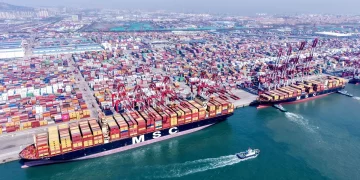Introduction
- India’s Economic Rise: Provide an introduction to India’s recent economic performance, discussing its position as one of the fastest-growing major economies. India has emerged as a global economic powerhouse, with a significant demographic advantage and a growing middle class.
- India’s Current Growth Trajectory: Outline India’s impressive growth rates over the past decade and its ambitions to become a $5 trillion economy by 2025. Discuss the growth of key sectors such as information technology (IT), manufacturing, and services.
- Purpose of the Article: The article will explore how India can sustain and possibly accelerate its economic growth amidst rising global challenges such as inflation, global economic instability, and environmental challenges.
Section 1: The Drivers of India’s Economic Growth
- Demographics and Workforce:
- Young Population: Discuss India’s demographic advantage, with a large and young population that drives both consumption and labor supply. The growing middle class is a key contributor to domestic demand and investment.
- Urbanization: Urbanization is another important factor driving economic growth. How will India’s cities evolve, and what impact will this have on infrastructure development, consumer behavior, and productivity?
- Digital Transformation and Technology:
- The Digital Economy: Analyze the growth of India’s digital economy, including fintech, e-commerce, and the IT sector. India’s rapidly growing digital infrastructure is enabling innovation and enhancing productivity in various sectors.
- Start-up Ecosystem: India’s burgeoning start-up ecosystem is another driver of growth. Explore how innovation in sectors like healthtech, edtech, and agritech is contributing to economic dynamism.
- Industrialization and Manufacturing:
- “Make in India” Initiative: Assess India’s efforts to boost manufacturing through initiatives like “Make in India.” Discuss how the government is incentivizing the development of key sectors such as electronics, automotive, and renewable energy.
- Industrial Growth and Export Potential: Examine India’s growing role as a manufacturing hub and the potential for increased exports to meet the demands of the global market.
- Services Sector Growth: Highlight the significance of India’s services sector, particularly IT and business process outsourcing (BPO), which has been a key pillar of economic growth for years.
- Global Demand for Indian Services: Examine how the global demand for Indian services, including software development, IT outsourcing, and customer support, drives growth.
Section 2: Global Challenges Confronting India’s Growth
- Rising Inflation and Supply Chain Disruptions:
- Global Inflationary Pressures: India, like many other economies, is facing rising inflation due to higher commodity prices, particularly oil, food, and raw materials. Analyze how inflation is impacting consumer spending and business costs in India.
- Supply Chain Disruptions: Explore the impact of global supply chain disruptions, especially in the wake of the COVID-19 pandemic. How are these disruptions affecting India’s manufacturing and export sectors, and what measures is the government taking to mitigate these challenges?
- Geopolitical Tensions and Trade Disruptions:
- US-China Trade War and Regional Instability: Discuss how geopolitical tensions, including the trade war between the U.S. and China, regional security issues, and the ongoing Russia-Ukraine conflict, are impacting India’s trade relations and investment flows.
- China-India Relations: Explore the complex relationship between India and China, including trade, security concerns, and how this dynamic could affect India’s long-term growth prospects.
- India’s Strategic Alliances: Analyze how India is positioning itself on the global stage by forming strategic alliances with Western nations, regional partners, and multilateral organizations like the Quad (United States, Japan, Australia, and India).
- Climate Change and Environmental Challenges:
- Climate Risks: Discuss the vulnerability of India to climate change impacts, including extreme weather events, rising sea levels, and shifting agricultural patterns. These environmental challenges have significant implications for India’s agriculture and infrastructure sectors.
- Transition to Renewable Energy: Analyze India’s efforts to transition to renewable energy sources as part of its commitments under the Paris Agreement. While renewable energy offers long-term benefits, the short-term challenges include financing, infrastructure development, and energy security.
- Sustainable Growth and Development: Discuss how India can balance its growth objectives with sustainable development goals. This includes adapting to climate change, protecting biodiversity, and ensuring sustainable agriculture.
Section 3: India’s Response to Global Economic Challenges
- Government Policy and Economic Reforms:
- Economic Reforms and Atmanirbhar Bharat (Self-Reliant India): Discuss the government’s reforms to encourage economic self-sufficiency, focusing on industrial policies, regulatory reforms, and the push for local manufacturing.
- Tax Reforms and Ease of Doing Business: Assess the importance of India’s tax reforms, such as the Goods and Services Tax (GST), and efforts to improve the business environment by reducing bureaucracy and making it easier for businesses to operate in India.
- Infrastructure Development:
- National Infrastructure Pipeline: Examine India’s efforts to improve infrastructure through projects like the National Infrastructure Pipeline (NIP), which aims to attract private investment and create jobs. How will these infrastructure improvements support long-term economic growth?
- Smart Cities and Urbanization: Discuss urbanization as a long-term trend and India’s plan to build 100 smart cities with state-of-the-art infrastructure. How will this drive productivity, attract investments, and support sustainable growth?
- Labor Market and Skill Development:
- Skilling India: Address the critical need for skill development to support India’s young population. Programs aimed at improving education, vocational training, and technology-based skills will be crucial for preparing the workforce for the demands of the future economy.
- Labor Market Flexibility: Explore how labor market reforms could boost employment and productivity by making it easier for businesses to hire workers while protecting workers’ rights.

Section 4: Impact of Global Economic Shifts on India
- Global Economic Slowdown:
- Impact of a Global Recession: Analyze how a potential global economic slowdown or recession could impact India’s growth prospects. India’s export-oriented sectors, including IT, pharmaceuticals, and manufacturing, would be affected by reduced global demand.
- Inflation and Rising Commodity Prices: How would the global rise in energy and commodity prices affect India? Since India imports a significant amount of oil and raw materials, rising global prices could exacerbate inflation and hurt domestic consumers and businesses.
- Global Technological and Digital Shifts:
- Digital Transformation: Explore how global technological trends, such as the rise of artificial intelligence (AI), automation, and big data, are affecting India’s economy. While India has a competitive edge in IT and software development, how can India ensure it remains at the forefront of this digital transformation?
- Technology and Innovation: How can India leverage its growing tech ecosystem to capitalize on global technological advancements? Discuss initiatives to promote innovation, such as the Digital India program and support for start-ups.
- Shifts in Global Trade and Investment:
- Diversification of Trade Partners: India’s trade relationship with China and the U.S. is central to its economic future. Explore how India is diversifying its trade partnerships, with a focus on strengthening its ties with ASEAN countries, Europe, and Africa.
- Foreign Direct Investment (FDI): Analyze the role of foreign investment in India’s economic growth. With the country’s reforms, can it attract more FDI, especially in high-tech industries, infrastructure, and green energy?
Section 5: Prospects for India’s Long-Term Growth
- Growth in Key Sectors:
- Manufacturing and Export Potential: India’s potential to become a global manufacturing hub remains strong. How can India capitalize on the shift in global supply chains due to the ongoing tensions between the U.S. and China?
- Renewable Energy: India’s emphasis on renewable energy and the green economy can help the country diversify its energy sources and reduce dependency on fossil fuels. How will this affect India’s energy security and economic future?
- Digital Economy: The continued growth of India’s digital economy presents new opportunities for entrepreneurship, innovation, and global leadership in sectors like fintech and artificial intelligence.
- Challenges to Overcome:
- Inequality and Inclusive Growth: Despite strong growth, India faces significant income inequality. How can India ensure that growth is inclusive, addressing poverty, unemployment, and regional disparities?
- Environmental Sustainability: Balancing rapid economic growth with environmental sustainability is a key challenge. India must prioritize green development, renewable energy, and climate change adaptation.
Section 6: Conclusion
- Summary of Key Insights: Summarize the key points discussed, including the factors contributing to India’s growth, the challenges it faces, and the strategies being employed to maintain growth in the face of global challenges.
- Future Outlook: Reflect on India’s future economic prospects. Will India be able to sustain its growth amidst global economic uncertainties and geopolitical tensions? What measures should India prioritize to ensure a resilient and sustainable economy in the coming decades?
- Call to Action: India’s growth story is promising, but it must remain adaptive and strategic in the face of global shifts. Sustainable development, digital innovation, and global partnerships will be essential to securing India’s future as an economic leader.


































